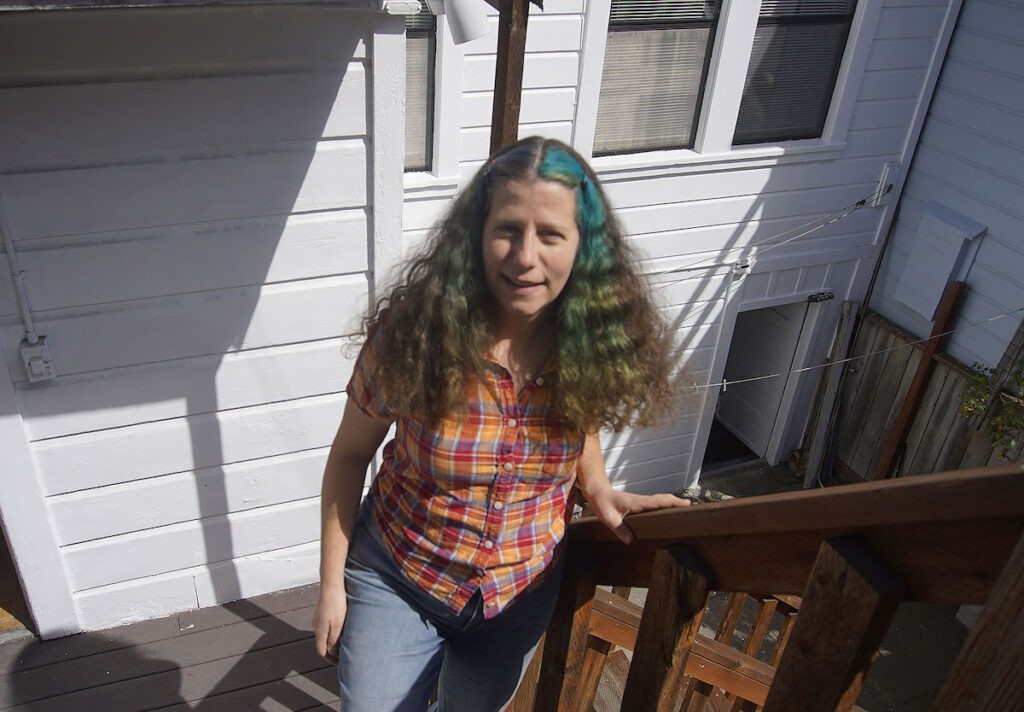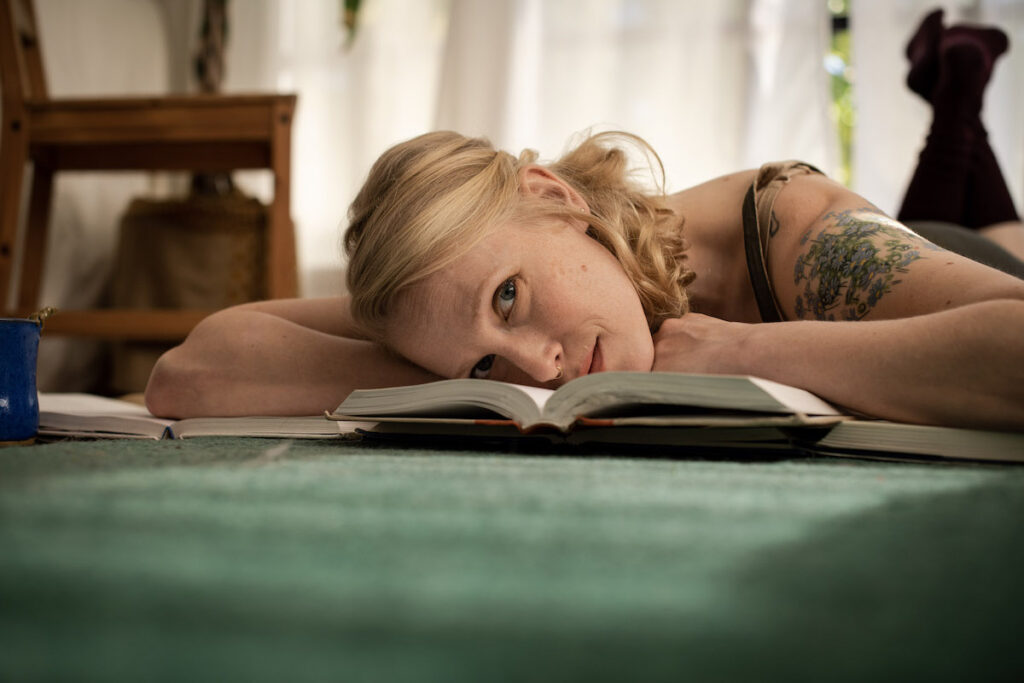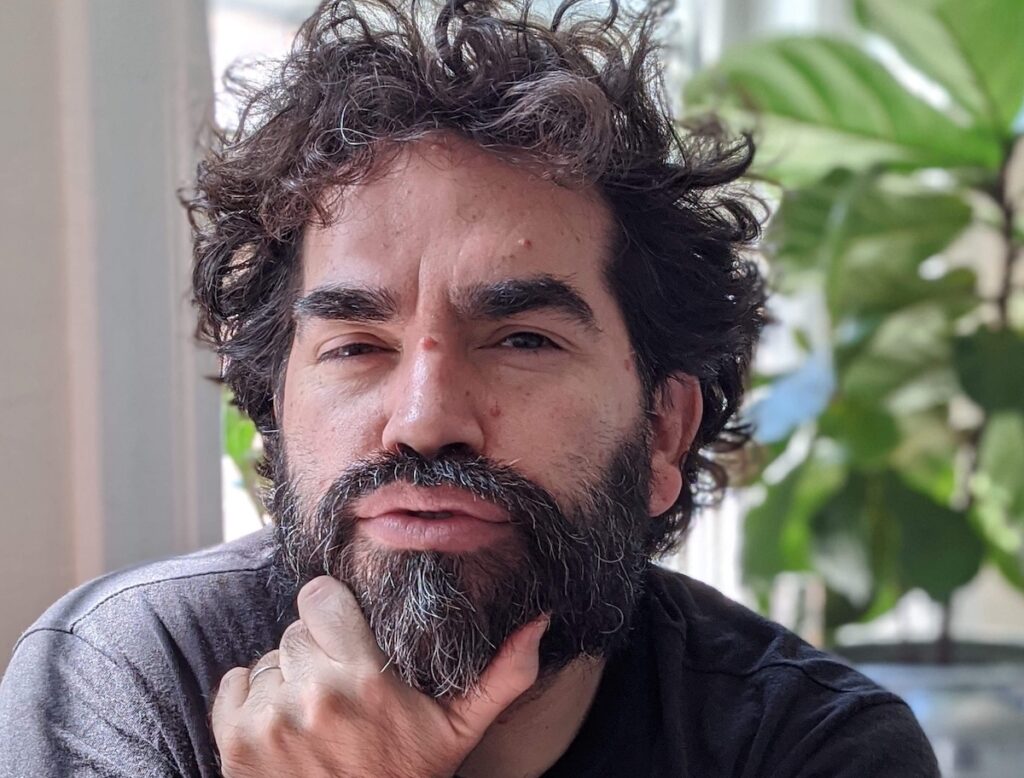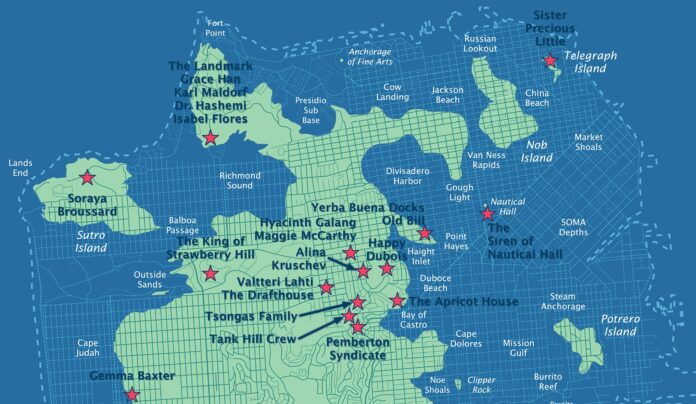One could argue that San Francisco winter 2023 has been the Season of Gluckstern. Nicole Gluckstern, that is, longtime local arts writer-promoter-producer-everything-else. Not long after she kicked off Substrate, the new local arts magazine she co-founded with several other terrific forces of nature, she’s now bringing her new eco-apocalyptic radio play, The Forever Wave (Sat/4-March 28), to community stations around the Bay Area, including KALW, KSFP, BFF.FM, and Radio Valencia. (You can find a full broadcast schedule and donate to the free project here.)
“In retrospect it was probably a bad idea to launch both of my dream projects in the same 12 weeks,” Gluckstern, who also co-operates the essential Bike to Books literary cycling tour, laughs. Yet here she is, with her first full-length play, a remote/radio production accessible totally for free. And it’s a doozy.
Taking its cue from Dylan Thomas’ eternal 1954 broadcast drama Under Milk Wood (and a number of online/radio dramas produced locally throughout the pandemic), The Forever Wave is a large-scale conception that confronts a climate-ravaged future—and there’s even a nifty “San Francisco Archipelago” map you can download to help follow along. “Set in a drowned Bay Area, circa 2070, The Forever Wave imagines the survivors of this water-logged world as occupying the tops of hills, individual islands jutting up from a climate-change induced tide that rolled in one day and never rolled out.
“What communities will emerge in a future where our systems have collapsed and our ‘normal’ is a historical relic? What can the hilltop-dwellers of the future teach us about ourselves in the now? And what are the things we can start building in order to avoid their fate?”

A multigenerational, multicultural, and multilingual cast of 12 brings dozens of characters to life, all narrated by Megan Trout and Nathaniel Justiniano, with music by Banda Sin Nombre and Mark Gowden, and map design by Brian Stokle and Burrito Justice. I spoke to Gluckstern about the evolution of the project, what it’s all about, and the delightfully unexpected (if also sadly necessary) return of radio and broadcast plays in the past three years.
48 HILLS I think some of us are familiar with Under Milk Wood, with its omniscient narrator drifting in and out of dozens of characters’ dreams and thoughts in a Welsh fishing village—but not in such an apocalyptic context. What’s the relationship between that radio play and The Forever Wave?
NICOLE GLUCKSTERN So the funny thing about Under Milk Wood is that it did not originally inspire me to do a radio play. In a way it was just the opposite. I love Under Milk Wood a lot, and I had been thinking of a way to stage it, as in onstage, for a long time. But I really found it difficult to visualize how I would do it. There are over 70 characters in that play! And the landscape is very much a part of the movement within it, so in a black box theatre it would be a challenge just to figure out how to set the scene, let alone have it continually changing, line by line. While I know other theatre-makers have staged it in-person in the past, I wanted to do my own production of it, so didn’t want to emulate whatever someone else had already done. Basically, it was just an idea that remained in a kind of stasis.
Then we had this pandemic (perhaps you heard!) and folks were reimagining “theatre” and theatricality in all kinds of ways. And overall, of all of those experiments, the productions that I ultimately felt “worked” best were the productions that were staged as radio plays. I enjoyed the SF Mime Troupe’s version for example, as well as the work coming out from Word for Word, Aurora Theatre, and other companies. So honestly it wasn’t until this moment in time that I realized that duh! Under Milk Wood was originally written and performed as a radio play. So it never needed to be produced as a piece of black box theatre at all. I could do it on the radio. WHAT A REVELATION, omg!
Now, the moment is set. Radio plays are making a pandemic-resurgence and I can visualize myself working in that medium. But along the way I’ve realized something about Under Milk Wood which is that although it is a very special play to me and perhaps I will still do it in the future, what it is not is a play that feels particularly of this moment. It’s almost too quaint and maybe doesn’t say all of the things that I want a play to say in the now. So that’s when I realized I was going to have to adapt it.
Fortunately, I had already been thinking about writing a play set in the drowned San Francisco of the future.

48 HILLS That is definitely a Plan B! Why did you have that in mind, and how does it particularly apply to the moment, beyond the obvious climate nightmare we’re experiencing.
NICOLE GLUCKSTERN There are a couple of reasons. One, I feel that science fiction and fantasy are overlooked genres, theatrically. There are some playwrights and companies working in that arena but not many. The loss of Quantum Dragon Theatre, for example, has definitely left a gap. Second, because San Francisco history and mapping projects are kind of my jam, it felt very much in line with that particular focus as well. In fact, a big inspiration for both this project and the Bikes to Books project was a map that Burrito Justice and Brian Stokle created in 2012 of the “San Francisco Archipelago” which imagines the San Francisco of 2070 after a 200′ sea level rise.
So I already had this visual aid to work from, and because Burrito Justice is a true pal and a consummate collaborator, he agreed to make edits to the map so we have a “Forever Wave” edition of it (which is downloadable for free on the website!).
Incorporating climate change into a play has been an idea I’ve been playing around with for some time. I do think it’s a topic that is pretty fraught and scary and therefore challenging to find a way to talk about or explore creatively without coming off as heavy-handed. A play that I think tackled the topic playfully was Megan Cohen’s Free for All in 2019, and while this play is not the same, it was a good model for using climate change as a central conceit without making it a play about “climate change is bad and here’s why.”
Instead what I wanted was to explore climate change as a real thing that will have real repercussions but to do it in a way that also explores the resilience of survivors adapting to, and even thriving within, a new set of circumstances.
48 HILLS So tell us a little about the play itself.
NICOLE GLUCKSTERN I wanted this play to retain the things that I love about Under Milk Wood, one of which there’s no real overarching narrative. It’s very much an ensemble piece and rather than an arc it’s almost a full circle. It takes place over the course of a single day from dawn to midnight, and the characters speak to themselves and to the living and to the dead as if there were no real difference between those planes of existence.
Several key characters are, in fact, dead, representing the layers of village history embedded within their memories. There’s poetry and song. There’s an internal joyousness that is key to the piece. So my goal was to also create a play that echoed these aspects rather than creating a world that was only gloomy and dismal and post-apocalyptic in the more traditional sense. This is a future vision that is kind. Collaborative. Resilient. Even fun!

48 HILLS I love the diversity of the cast—how did you assemble everyone in this day and age to participate in your vision?
NICOLE GLUCKSTERN Thank you for noticing the superlative cast and crew! I feel very fortunate and very honored to have worked with such an amazing group of humans. For me it was very very important to write a play that spoke to and represented the diversity of the Bay Area, and then cast according to that vision. One of the challenges of course was casting just the right number of folks because while it would have been very cool to have 70 cast members each playing one voice, that was realistically not going to work. Certain characters were written to be culturally specific, so you could not just cast anyone in those roles.
I worked very hard to balance these considerations as I developed and cast the work, and wow. What a gift to the Bay area that these 12 individuals said “yes” to being in this play. Not only that, but to have the music of Mark Growden and Banda Sin Nombre—musicians to me who represent so much of what I love artistically in San Francisco—plus the amazing sound design by Cliff Caruthers, who is a co-curator of the Tape Music Festival and a highly in-demand sound designer for theatres around the country. I mean!
As a person who has been embedded in the independent theatre community for many years, and a producer of underground theatre events, I’ve long felt that one of my superpowers is curation. There’s almost nothing I love more than bringing artists together from very different performance backgrounds and disciplines and putting them on the same stage (or living room! or radio broadcast!) and watching the magic happen. It’s a great audience experience too, because it really cross-pollinates the different audiences who support certain work or certain artists and brings them together.
48 HILLS With a lot of the theater scene feeling so all over the place in terms of COVID protocols, it’s nice that things like The Forever Wave offer super-safe alternatives.
NICOLE GLUCKSTERN The entire process of recording and mixing and developing this play happened remotely. This was also one of my goals. I wanted to challenge myself to create and distribute work fully remotely because I’m personally not to the point yet where I want to feel responsible for someone’s COVID exposure. I know we’d all really like to be “over” the pandemic. But it is not over. Maybe it will never be fully over.
And so, even if in-person shows are back on track, I think there are always going to be people who appreciate and maybe even need to access work remotely. And that is OK, and we should be creating work that can be accessed in all kinds of ways. It also meant I could cast folks who are not currently living in the Bay Area, and that our audio engineer could finish his work all the way from Jamaica! An international collaboration!
What I love about this idea of a community radio “tour” especially is getting my work into neighborhoods where I might not necessarily be able to produce an in-person show. It’s another layer to that cross-pollination of different audiences. Why not broadcast on weekend in the Castro, one in the Mission, one in Alameda, and beyond? And we’re still finalizing the broadcast schedule, so watch for some North Bay and East Bay dates as well as more SF locations to be announced soon, and tune in!
THE FOREVER WAVE kicks off Sat/4, 8pm-10pm on KSFP 102.5 LP FM, (also sfpublicpress.org/ksfp) broadcasting from Sutro Tower in San Francisco, and then continues with other dates around the Bay Area. See the full schedule here.




